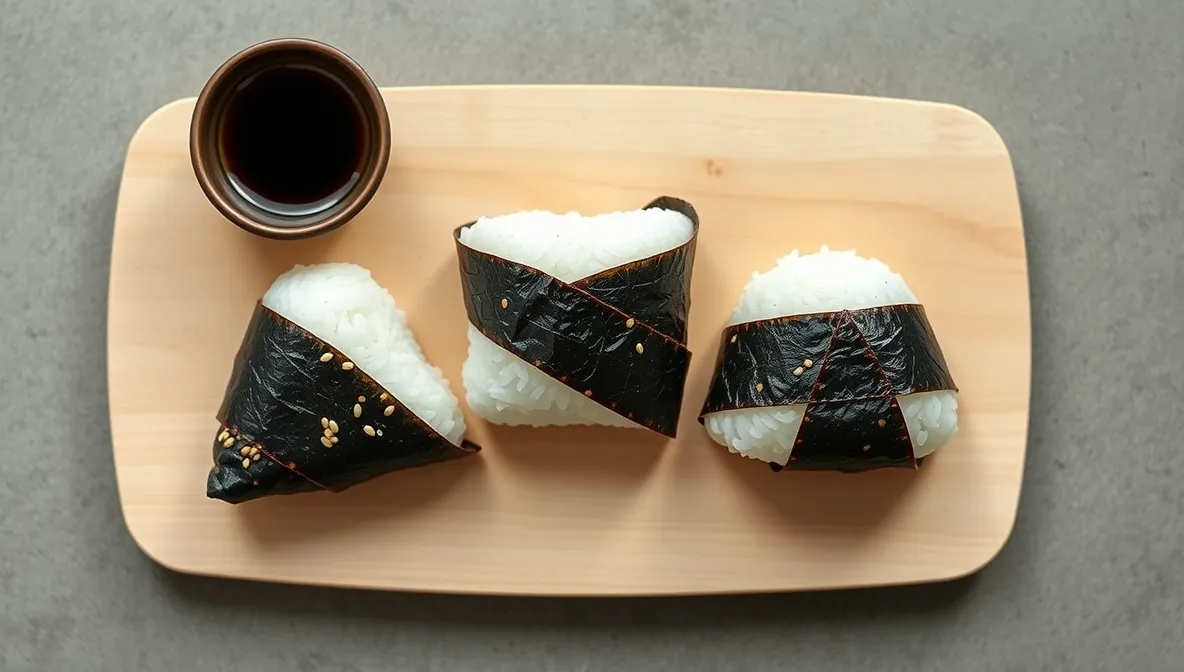The term **Japanese Mounjaro recipe** has recently captured attention in the health community, though it refers not to a pharmaceutical compound, but to a traditional, simple Japanese food preparation—specifically, **Onigiri** (rice balls). This method of consuming rice focuses heavily on portion control, slow digestion, and accessible, whole ingredients, making it an **amazing** and sustainable approach to managing weight.

The **Japanese Mounjaro recipe for weight loss** is essentially a strategic way to consume complex carbohydrates and lean protein in pre-portioned amounts, promoting satiety and stability. This traditional preparation is already a staple in Japan, known for being fast, filling, and easily customized. This recipe is an ideal fit for both **Lunch** preparation and your **Quick Recipes** menu.
- Understanding Resistant Starch in the Japanese Mounjaro Recipe
- The Power of Portion Control and Prep
- Preparing the Base and Filling:
- Shaping and Finishing the Onigiri:
- Low-Calorie and Flavor Variations:
- Meal Prep and Storage:
- FAQ: Your Questions About Japanese Mounjaro Recipe
- Conclusion: The Ultimate Secret to Portion Control
- Recipe Summary: Quick Japanese Mounjaro (Onigiri)
- Steps to Follow (How to Make Onigiri)
- Tools You’ll Need
The Science Behind the Japanese Mounjaro Recipe for Weight Loss
The effectiveness of this simple food lies in its composition, which naturally encourages slower eating and better metabolic response compared to typical Western processed foods.
Understanding Resistant Starch in the Japanese Mounjaro Recipe
The key metabolic advantage of the **Japanese Mounjaro recipe** is its reliance on **cold rice**. When starchy foods like rice are cooked and then cooled, a portion of the starch converts into “resistant starch.”
- **Resistant Starch:** This type of starch resists digestion in the small intestine, acting like soluble fiber.
- **Benefits:** Resistant starch slows down the absorption of sugar into the bloodstream, which stabilizes insulin levels and promotes a greater feeling of fullness (satiety). This natural process aids in weight management and prevents energy spikes and crashes.
Therefore, the simple act of using chilled, cooked rice for your **Japanese Mounjaro recipe** transforms the carbohydrate structure into a more metabolically friendly food. For more information on the benefits of resistant starch, consult this authoritative guide from **WebMD on Resistant Starch**.
The Power of Portion Control and Prep
Onigiri (the traditional format of the **Japanese Mounjaro recipe**) enforces natural portion control. Each rice ball is typically a precise, single serving of carbohydrate, making calorie tracking simple. This format is perfect for **Lunch** meal prep.
Step-by-Step Instructions: How to Make Japanese Mounjaro Recipe
Making Onigiri is simple, but precision in the rice preparation is crucial for texture and flavor.
Preparing the Base and Filling:

You must use freshly cooked, **short-grain Japanese rice**. Once cooked, let it cool to warm or room temperature—never use hot rice, as it will steam your hands and won’t hold its shape.
- **Cook and Cool Rice:** Cook your rice according to package directions. Spread the hot rice on a sheet pan to cool quickly to room temperature.
- **Prep Filling:** Choose a simple, lean filling. Popular traditional choices include cooked and flaked salmon, tuna salad (made with light mayo or Greek yogurt), *umeboshi* (pickled plum), or cooked chicken breast.
Shaping and Finishing the Onigiri:
- **Wet Hands:** Wet your hands with water and sprinkle a generous pinch of salt onto your palm. The salt is essential for seasoning the rice and preventing the sticky rice from sticking to your hand.
- **Form the Core:** Take a palm-sized portion of rice (about $\frac{1}{2}$ to $\frac{3}{4}$ cup). Make a slight indentation in the center with your thumb and add a small spoonful of your filling (e.g., flaked salmon).
- **Shaping:** Close the rice over the filling, sealing it completely. Gently compress the rice into a triangle, ball, or cylinder shape, rotating and pressing with your palms and fingertips. Avoid over-squeezing, which can make the rice dense.
- **Wrap:** Wrap the base of the rice ball with a strip of nori seaweed. The nori serves as a handle for eating and adds a contrasting savory flavor.

Serving and Customization for Japanese Mounjaro Recipe
The **Japanese Mounjaro recipe** is designed for high portability and versatility, making it a perfect meal for anyone seeking **Dinner** or **Lunch** solutions.
Low-Calorie and Flavor Variations:
- **Flavor Infusion:** Mix the cooked rice with a dash of rice vinegar, toasted sesame seeds, or fine sea salt before shaping to enhance the flavor of the base rice.
- **Vegetable Boost:** Mix finely chopped vegetables (like cooked carrot, edamame, or scallions) into the rice *before* shaping for added fiber.
- **High-Protein Focus:** Use a filling of grilled chicken breast or light tuna (made with Greek yogurt instead of mayonnaise) to maximize the protein content, enhancing the “weight loss” appeal of the **Japanese Mounjaro recipe** variation.

Meal Prep and Storage:
Onigiri are ideal for **Quick Recipes** and meal prep. They should be wrapped tightly in plastic wrap immediately after shaping to prevent the rice from drying out. Store them in the refrigerator and consume within 2 days. For a convenient savory dinner, you can serve these rice balls alongside another high-protein, quick dish, such as our guide to the speedy **[Beef Sesame Seeds]** stir-fry (https://flavorillarecipes.com/beef-sesame-seeds).
If you’re interested in other simple, authentic Japanese meals, you might enjoy our guide on the science of high-heat cooking for our **[Fried Rice Recipe]** (https://flavorillarecipes.com/fried-rice-recipe), which also uses chilled rice as its core component.
The **Japanese Mounjaro recipe** is a powerful tool for mindful eating. The enforced act of shaping and focusing on simple, whole foods is inherently beneficial for managing appetite and promoting healthier habits. This simple technique, honed over centuries, is far more effective than fad diets.
FAQ: Your Questions About Japanese Mounjaro Recipe
What is the Japanese Mounjaro recipe?
The **Japanese Mounjaro recipe** refers to Onigiri, a traditional Japanese rice ball that is shaped and filled with various ingredients (like tuna, salmon, or pickled plum) and wrapped in nori seaweed. It is a portion-controlled meal that is naturally metabolically favorable due to the resistant starch in the cooled rice.
What kind of rice do you use for Onigiri (Japanese Mounjaro)?
You must use **short-grain Japanese rice** (sushi rice) for Onigiri. This rice is sticky and high in amylopectin starch, which allows the grains to stick together firmly enough to be shaped without falling apart. Long-grain rice will not work for this preparation.
How long does Onigiri last in the fridge?
Onigiri (the **Japanese Mounjaro recipe**) should be consumed within **48 hours (2 days)** of preparation. For the best flavor and texture, they should be wrapped tightly in plastic wrap and stored in the refrigerator, preventing the rice from drying out and the nori from becoming tough.
Is the Japanese Mounjaro recipe safe for a gluten-free diet?
Yes, the **Japanese Mounjaro recipe** is naturally gluten-free. It uses only rice, salt, and water. However, you must be careful with the filling (ensure soy sauce used in savory fillings is certified gluten-free) and any seasonings or toppings to prevent cross-contamination.
Conclusion: The Ultimate Secret to Portion Control
The **Japanese Mounjaro recipe** offers a simple, effective, and delicious strategy for health and mindful eating. By embracing this traditional method of portion-controlled consumption, you can utilize the metabolic benefits of resistant starch and lean protein.
This **amazing** **Japanese Mounjaro recipe for weight loss** is a versatile and rewarding addition to your **Lunch** and **Quick Recipes** rotation, proving that the simplest foods are often the most powerful.
Recipe Summary: Quick Japanese Mounjaro (Onigiri)
→ Ingredients
- 3 cups cooked, warm Short-Grain Japanese Rice
- 1 tsp Fine Sea Salt
- Fillings: Flaked Cooked Salmon, Canned Tuna (mixed with light mayo/yogurt), Umeboshi (pickled plum), or cooked chicken.
- 1 sheet Nori Seaweed, cut into strips (for wrapping)
Steps to Follow (How to Make Onigiri)
- **Cool Rice:** Cook short-grain rice and let it cool to room temperature.
- **Prep Hands:** Wet hands with water and sprinkle a pinch of salt onto your palm.
- **Shape and Fill:** Take about $\frac{3}{4}$ cup of rice. Press the center, add a small spoonful of filling, and seal the rice around it. Gently compress the rice into a triangle or ball shape.
- **Serve:** Wrap the base with a strip of nori seaweed. Serve immediately or wrap tightly in plastic film for **Lunch** prep.
Tools You’ll Need
- Rice Cooker or Pot
- Plastic Wrap or Onigiri Molds (optional)
- Nori (Seaweed) Sheets

